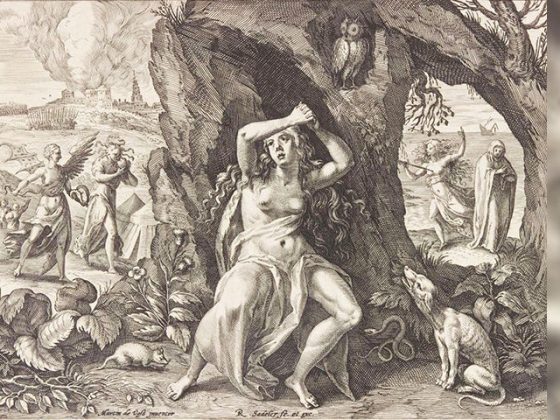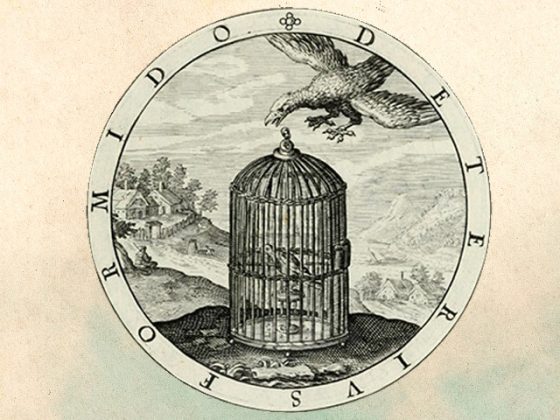Dear friends:
I am sending you on this occasion the present engraving that appears on the frontispiece of the book Vorboten der am philosophischen himmel hervorbrechenden Morgen-Röthe, ‘The Herald of Dawn that Breaks into the Philosophical Sky', written by Johan de Monte Raphaim ─probably a pseudonym─, and published in 1716 in Hamburg, Germany. I am including two versions of the drawing: the first original of the book and the second a more popular version of a later edition.

This engraving, patient reader, brings to mind one of the most precious symbols of Alchemy; we refer to the Mercury of the sages.
First of all, we must clarify that the word in the center belongs to ancient Greek, consisting of an upsilon, a lambda ─equivalent to an l─ and an eta ─an open long e─.
It is transliterated as Hyle and reads as [hule] or [hile], and means ‘matter'. It is the same word that appears in the exorcism of salt when we are told: recedant ab isto fantasmata hyle. Aristotle used it in his philosophy to indicate the primal matter.
It is therefore an invitation to extract something from the primordial primal matter: the Mercury of the sages.

I would like to point out to you that the symbols at the vertices of the smaller triangle, or rather between the vertices of the two central triangles, the one at the top —a triangle on a cross—represents Sulphur, the bottom left —a circle cut in half— represents Salt, and the bottom right represents Mercury; therefore, the three elements of Alchemy are present here.
The words Agens, Patiens, Essent, Quint mean: ‘active', ‘patient', ‘essence', ‘fifth'. This could be translated as ‘by being active and patient, we reach the quintessence'.
Considering that the head of the right key looks very similar to the symbol of silver or of the Moon ─similar to two letters C facing each other─, and that of the key on the left is rounder, like an O ─which is the symbol of the Sun and gold─, we find it logical that the first key indicates Mercury and the second Sulphur, or the first the white elixir and the second the red.
The first is in Mercury's hand with an active attitude, the second hangs on his arm with a passive attitude, perhaps to say that the active force must work with the white elixir and the passive force needs the red elixir.
GENERAL DESCRIPTION:
Mercury, the principal agent of the Great Work, appears here surrounded by his attributes. The image presents him with a helmet and winged boots to symbolize his evaporation in our inner nature.
In his right hand he carries a key marked with the word Claudo, meaning ‘I close', and Teo in the cipher of the key, from the Greek Theos, which means ‘God'.
But what is it that God certainly closes? Answer: Our lunar nature.
On his left arm he holds a caduceus and a key marked with the word Aperio, meaning ‘I open', and two letters H in the cipher, one on top of the other.
Here it is worth asking ourselves: what does Mercury open for us? Answer: Mercury opens up access to all the kingdoms of nature and to all the dimensions of space.
The Letter H suggests the Halitus or divine breath capable of penetrating everything.
Mercury also appears upon a circle surrounded by the words Animalia, Vegetabilia, Mineralia and Astralia, animal, plant, mineral and stellar kingdom, giving us to understand that it was Mercury who formed the GNOSTIC ARCHE from which the galaxies and all the dimensions of the cosmos emanated. We could summarize by saying that Mercury was the primary auxiliary of creation itself.
Within the circumference in which Mercury is found are the words Chaos, Materia, Prima, Magnesia, Lapis; ‘chaos', ‘matter', ‘primal', ‘magnesium', ‘stone'. Obviously, Mercury is born from the primordial chaos, it becomes the primal matter, the Magnesium component of the quintessence, all of which gives rise to the PHILOSOPHER’S STONE.
Within all this we find a square with the four elements labeled on each of its sides, namely: Ignis, Aqua, Terra, Aer; ‘fire', ‘water', ‘earth', ‘air'.
Within this square we also find the words that would probably be read Agens, Patiens, Essent, Quint, as explained above.
We see two triangles that have written on their sides Separa, Dissolve, Depura; ‘separate', ‘dissolve', ‘purify'. What do those words mean? Mercury has its first manifestation as a dark matter that must be separated by means of the sublimation of the transmutatory art. Subsequently, the undesirable atomic elements that are hidden within it will have to be dissolved. This then leads us to its purification, that is, to the crystalline nature of our mercurial agent.
Next we see the words Anima, Spiritus, Corpus; ‘soul', ‘spirit', ‘body'; this would be the mercurial soul and then the mercurial spirit—the internal vehicles created in the Adept—and the body or solidification of the character of glory of the Initiate.
Inside the last triangle we find the word Extrahe, ‘to extract'.
At the vertices, as we have said, are the symbols of Salt, Sulphur and Mercury, original components of the inner Great Work.
We must not overlook the caduceus that the Olympian divinity carries in his left hand. Such caduceus is the representation of the IDA and PINGALA channels of our metaphysical nature, and through which the vapors of our particular mercurial substance ascend during the metaphysical coitus. That is the Great Arcanum A.Z.F. of the eternal Gnosis.
Finally, I would like to add a few quotations for your reflection:
“Victory belongs to the most persevering.”
Napoleon
“To win without danger is to triumph without glory.”
Seneca
“No vanquished receives justice if he is judged by his victor.”
Quevedo
“The Universe is an infinite sphere whose center is everywhere and whose circumference is nowhere.”
Pascal
“Every man is the center of the Universe. The Universe, like space, according to the famous definition, has its center in each soul and its circumference is in none.”
Amado Nerve
TANDEM FELIX.
─'Finally happy'─.
KWEN KHAN KHU





